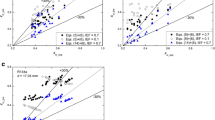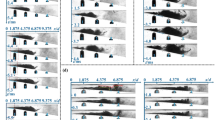A flashing flow occurs after a high-temperature liquid flows through a Venturi tube, forming a flashing region downstream of the throat and generating an adaptive back pressure which will affect a vapor flow in front of the throat. To reveal the phenomenon, the effect of the condensate flow rate on the steam flow rate in a Venturi tube is explored experimentally with consideration for the installation angle impact. The two-phase mixture approach is used to numerically explain the flashing flow behavior. The radial steam volume fraction is not equal in the flashing region, and the highest steam fraction appears near the wall. The maximum water discharge for various constructions is predicted numerically. The steam flow rate at the output can be maintained low if the condensate flow rate is near the expected value. Furthermore, flashing is significantly more visible at smaller throat diameters, which results in a continuous increase in the radial steam volume fraction.
Similar content being viewed by others
References
J. P. Janet, Y. Liao, and D. Lucasand, Heterogeneous nucleation in CFD simulation of flashing flows in converging-diverging nozzles, Int. J. Multiphase Flow, 74, 106–117 (2015).
E. Faucher, J. M. Herardc, M. Barret, and C. Toulemonde, Computation of flashing flows in variable cross-section ducts, Int. J. Comput. Fluid Dyn., 13, No. 4, 365–391 (2000).
N. T. Thang and M. R. Davis, Pressure distribution in bubbly flow through Venturis, Int. J. Multiphase Flow. 7, No. 2, 191–210 (1981).
X. Huang and S. W. Van Sciver, Performance of a Venturi flow meter in two-phase helium flow, Cryogenics, 36, No. 4, 303–309 (1996).
T. Ishii and M. Murakami, Comparison of cavitation flows in He I and He II, Cryogenics, 43, No. 9, 507–514 (2003).
H. J. Richter, Separated two-phase flow model: Application to critical two-phase flow, Int. J. Multiphase Flow, 9, No. 5, 511–530 (1983).
F. J. Salvador, D. Jaramillo, J. V. Romero, and M. D. Roselló, Using a homogeneous equilibrium model for the study of the inner nozzle flow and cavitation pattern in convergent-divergent nozzles of diesel injectors, J. Comput. Appl. Math., 309, 630–641 (2017).
J. J. Schröder and N. Vuxuan, Homogeneous non-equilibrium two-phase critical flow model, Chem. Eng. Technol., 10, No. 1, 420–426 (1987).
R. E. Henry, The two-phase critical discharge of initially saturated or subcooled liquid, Nucl. Sci. Eng., 41, No. 3, 336–342 (1970).
Q. D. Le, R. Mereu, G. Besagni, V. Dossena, and F. Inzoli, Computational fluid dynamics modeling of flashing flow in convergent-divergent nozzle, J. Fluids Eng., 140, No. 10, Article ID 101102 (2018).
C. B. Oland, Review of Orifice Plate Steam Traps, Oak Ridge National Laboratory, Oak Ridge, Tennessee (1996).
R. Permatasari and A. C. N. Nawaksa, Comparison of steam losses among mechanical, thermostatic and thermodynamic steam trap with condensate removal device brand XYZ, AIP Conf. Proc., 2001, No. 1, Article ID 070001 (2018).
K. E. Kanyarusoke and I. Noblejack, Failed steam traps: First steps to replacement, Int. J. Adv. Eng. Technol., 3, No. 1, 606–617 (2012).
A. Sinha and S. Gopalakrishnan, Multidimensional simulation of thermal nonequilibrium flows in a convergent-divergent nozzle, Multiphase Sci. Technol., 31, No. 1, 73–85 (2019).
Author information
Authors and Affiliations
Corresponding author
Additional information
Translated from Inzhenerno-Fizicheskii Zhurnal, Vol. 96, No. 5, pp. 1372–1380, September–October, 2023.
Rights and permissions
Springer Nature or its licensor (e.g. a society or other partner) holds exclusive rights to this article under a publishing agreement with the author(s) or other rightsholder(s); author self-archiving of the accepted manuscript version of this article is solely governed by the terms of such publishing agreement and applicable law.
About this article
Cite this article
Han, X., He, W. & Li, SR. Experimental and Numerical Investigation of the Behavior of a Vapor–Liquid Mixture in a Venturi Tube. J Eng Phys Thermophy 96, 1361–1369 (2023). https://doi.org/10.1007/s10891-023-02802-0
Received:
Published:
Issue Date:
DOI: https://doi.org/10.1007/s10891-023-02802-0




